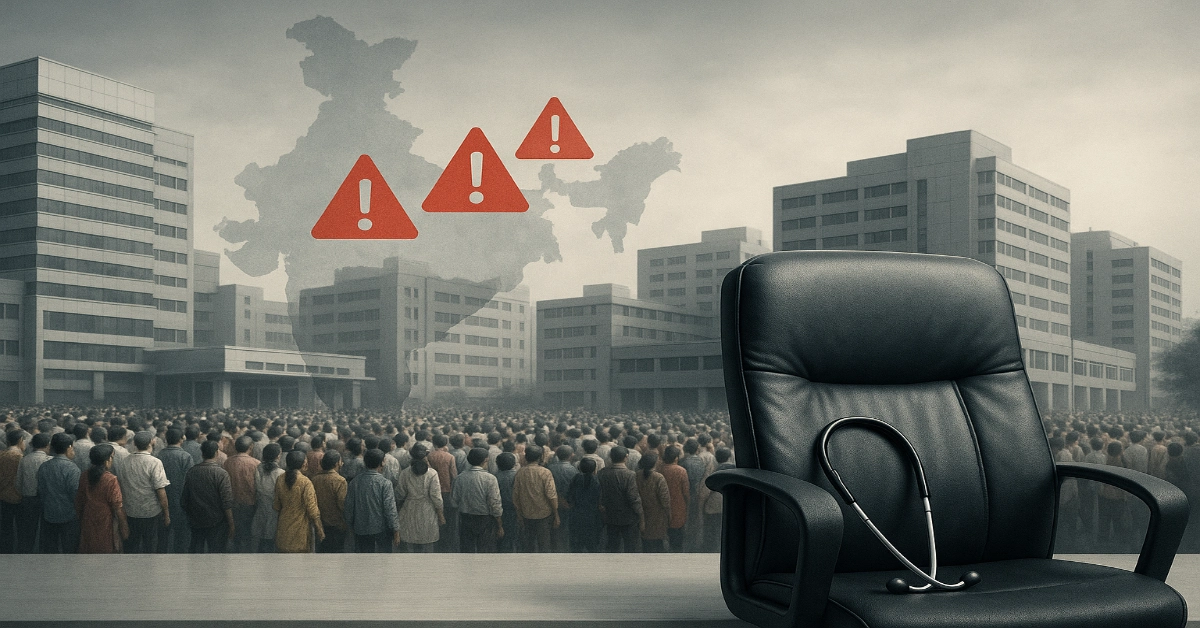India will face a severe doctor shortage in the coming years if the current MBBS and MD/MS output continues at the same pace, new data suggests. A recent research report published by Rajnish Kumar on Edufever, examining India’s doctor availability crisis, argues that government claims about the doctor-to-population ratio surpassing WHO norms (1:1000) are misleading and do not reflect the ground realities.
He also adds that to count total registered doctors with NMC for WHO norm deciding without discounting retired and emigrated doctors is wrong.
Let’s break key observations from that report.
Rapid Growth in Medical Colleges Since Independence
India’s healthcare system has undergone massive expansion over the past seven decades. At the time of Independence, the country had only 19 medical colleges. Today, the number has crossed 800, with more than 1.3 lakh MBBS seats available annually. Nearly half of these colleges are privately run.
Despite this growth, India continues to struggle with weak health indicators, raising questions about the effectiveness of medical capacity expansion.
Health Indicators Show Crisis
India’s performance on key health indicators remains below global and regional benchmarks. As of 2024:
- Life expectancy: 72.48 years
- Infant mortality: 24.98 per 1,000 live births
- Maternal mortality: 93 per 100,000 births
- Institutional skilled birth rate: 89.4%
By contrast, China has superior outcomes across all indicators, highlighting policy gaps despite comparable population size and development timelines.
Report argue that medical capacity expansion has not translated into equitable access or system-wide improvement.
| NEET PG Counselling Guide 2025 | |
|---|---|
| MCC NEET PG Counselling Guide eBook 2025 | 📥 Download |
| DNB Counselling Book 2025 | 📥 Download |
Doctor Production Has Increased, But the Active Workforce Is Far Smaller
Data shows a steep rise in registered doctors over decades. According to the National Medical Commission, India had 13,86,136 registered allopathic doctors as of July 2024. However, this number is misleading because it includes doctors who:
- Have retired or are nearing retirement
- Have migrated to other countries
- Are no longer practising
- Have shifted to non-clinical roles
Using age-based workforce modelling and migration estimates, research estimate that India currently has around 9 lakh active practising doctors, serving a population of approximately 150 crore.
This brings India’s effective doctor-population ratio to 6 doctors per 10,000 people, far below the WHO-recommended level of 10 per 10,000.
Brain Drain Continues to Weaken India’s Health Workforce
India remains one of the largest exporters of medical professionals. Nearly 1 lakh Indian-trained doctors are practicing in countries such as the US, UK, Australia, Canada, and Gulf nations.
In the UK alone, over 25,000 Indian doctors are registered. The United States has more than 48,000 Indian-origin physicians. Migration is fueled by better working conditions, higher salaries, and advanced medical infrastructure abroad.
Experts describe this as a critical human capital loss, especially when India still faces primary care shortages.
Urban-Rural Imbalance Worsens the Crisis
Most doctors prefer to work in metropolitan or urban areas. Maharashtra, Karnataka, Tamil Nadu, and Gujarat collectively hold a disproportionately high share of registered doctors. States like Bihar, Jharkhand, Madhya Pradesh, and Chhattisgarh face acute shortages.
Rural doctors cite several deterrents:
- Poor infrastructure and diagnostic support
- Lack of specialist backup
- Safety concerns
- Lower pay scales
- Limited career advancement
This results in dependence on informal practitioners and delayed medical intervention, especially in maternal and infant care.
Future Forecast: India Unlikely to Meet Global Standards by 2030
Projections suggest that if India maintains its current pace of growth in the medical workforce, the country will reach only:
- 17.3 lakh registered doctors
- 10.18 lakh active doctors
- 6.9 doctors per 10,000 population
by 2030.
To meet WHO standards, India would need at least 15 lakh active practising doctors, which requires building a total registered pool of 20 lakh doctors, an 80% workforce expansion by the end of the decade.
Report says such growth is unlikely without strategic reforms.
Structural Reforms Urgently Needed
Experts recommend a multi-level approach to address the widening gap:
- Create a Rural Medical Cadre for primary and emergency care.
- Expand and strengthen government medical colleges rather than relying heavily on private institutions.
- Shift focus to general practice and community medicine to meet rural demands.
- Offer incentives for mandatory rural service, including higher pay, career benefits, and PG reservation.
- Invest heavily in primary healthcare infrastructure such as diagnostics, ambulances, and digital health.
- Reduce brain drain through competitive wages and structured retention policies.
A Healthcare System Still Out of Reach for Millions
Despite producing more doctors than ever, India’s healthcare access gap remains wide. Policymakers and experts agree that the crisis is not only about the number of doctors but also about:
- Distribution inequity
- Workforce mismatch
- Underinvestment in primary care
- Lack of policy alignment with demographic needs
Without targeted reforms, India risks falling further behind global health standards, even as medical education infrastructure expands.
India stands at a crossroads. It has achieved significant expansion in medical education but struggles with outcomes due to systemic imbalance and inadequate planning. If current trends continue, India will miss WHO doctor-population norms by 2030, leaving millions, especially in rural regions, without timely access to qualified medical care.
Public health analysts caution that achieving “Health for All” will require more than increasing MBBS seats, it demands structural reform, balanced workforce distribution, and long-term planning rooted in equity and accessibility.

